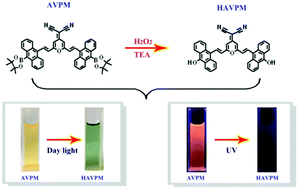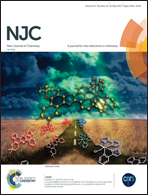Design, synthesis and properties of a reactive chromophoric/fluorometric probe for hydrogen peroxide detection†
Abstract
As the most important starting material and degradation product of peroxide explosives, H2O2 is considered as a signature compound for peroxide-based explosives. A new probe, (2-(2,6-bis((E)-2-(10-(4,4,5,5-tetramethyl-1,3,2-dioxaborolan-2-yl)anthracen-9-yl)vinyl)-4H-pyran-4-ylidene)malononitrile) (AVPM), for both chromophoric/fluorometric detection of H2O2 was designed and synthesized. AVPM emitted a long wavelength emission from its intramolecular charge transfer (ICT) and hence its absorption was expanded to the visible region. The response rate and sensitivity of AVPM for H2O2 detection were tremendously improved (91% of the fluorescence was quenched within 2 min for H2O2) by adding triethylamine (TEA) into the probe solution. And the solution color changed from yellow to blue. A detection limit down to 17.58 nM is remarkably achieved. These features lead to a new chromophoric/fluorometric probe for H2O2 detection and make it an ideal candidate for chemical detection and analysis in public safety and environmental monitoring.



 Please wait while we load your content...
Please wait while we load your content...